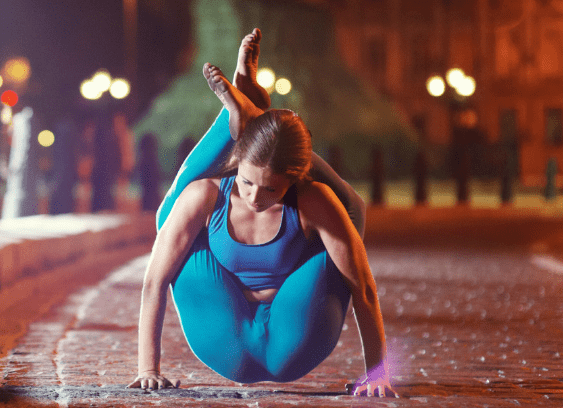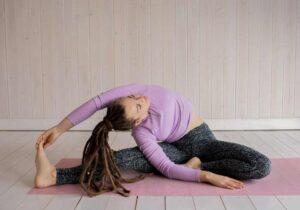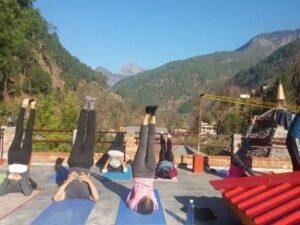One Foot to Head Pose (Mastering Dwi Pada Sirsasana)
There is a lot of yoga to explore, and each asana has its own special difficulties and benefits. Dwi Pada Sirsasana, or the Two Feet to Head Pose, is one such fascinating pose. Dwi Pada Sirsasana is a classic advanced pose that requires strength, flexibility, and concentration. Let’s explore this amazing posture’s application, advantages, and required safety measures.
Understanding Dwi Pada Sirsasana
The goal of Dwi Pada Sirsasana is to remain seated while putting both legs behind the head. This pose, which is a mainstay in Ashtanga yoga’s advanced series, is frequently considered as a progression from its cousin, Eka Pada Sirsasana (One Leg Behind the Head Pose).
Check Out: yoga teacher training in rishikesh
How to Practice Dwi Pada Sirsasana (One Foot to Head Pose)
Preparatory Poses
It’s important to warm up the body with postures that improve hip, hamstring, and spine strength before trying Dwi Pada Sirsasana. Several suggested warm-up positions consist of:
- The Eka Pada Rajakapotasana, or Pigeon Pose
- Forward Bend While Seated (Paschimottanasana)
Third Pose: Janu Sirsasana (Head to Knee) - Adha Konasana, or Bound Angle Pose
- The One Leg Behind the Head Pose, or Eka Pada Sirsasana
Step-by-Step Instructions
1. Warm-Up: To prepare the muscles, perform a comprehensive warm-up with an emphasis on the spine, hamstrings, and hip openers.
2. Starting Position:
- Start in the Dandasana, or seated position with your legs extended forward.
3. Placing the First Leg:
- Bring your right leg in close to your torso by bending it gently.
- With your right foot held in place, gently move it behind your head. It might be necessary to stoop a little forward in order to handle the positioning.
- Make sure your right leg is firmly planted on your shoulders, behind your neck.
4. Placing the Second Leg:
- Bend your left knee and bring it close to your chest while maintaining stability in your right leg.
- Position your left foot parallel to your right leg and slowly move it behind your head.
- To establish a steady balance, adjust both feet as needed.
5. Holding the Pose:
- Sit up straight after both legs are in position, using your core to stay balanced.
- Put your hands in front of your chest in a pose of prayer or on the ground next to your hips.
- Hold the pose for a few long breaths, trying to keep your mind steady and peaceful.
6. Releasing the Pose:
- To get out, carefully take one leg out in front of you at a time.
- Extend your legs gently and relax in a counter-pose, like a Supine Twist (Supta Matsyendrasana) or Child’s Pose (Balasana).
Benefits of Dwi Pada Sirsasana
There are several benefits to Dwi Pada Sirsasana practice, both psychologically and physically:
- Enhanced Flexibility: The hips, hamstrings, and spine all experience a notable gain in flexibility from this pose.
- Strengthens Core and Upper Body: It takes a lot of core and upper body strength to balance your legs behind your head.
- Improved Posture: Consistent practice leads to a better aligned and upright posture.
- Mental Focus and Concentration: This posture promotes mindfulness and lowers stress levels due to its complexity, which calls for a high level of mental focus.
- Detoxification: By improving circulation and digestion, the compression of the pose can help with internal detoxification.
Precautions and Contraindications
Since One Foot to Head Pose is an advanced pose, it should be done carefully. Remember to take the following safety measures:
- Warm Up Enough: To avoid tension or injury to the muscles and joints, make sure you are well warmed up.
- Pay Attention to Your Body: Steer clear of forcing the pose. To avoid getting hurt, respect your body’s limitations.
- Spinal and Joint Issues: This position should not be performed by anyone who has a herniated disc, a spinal injury, or serious hip or knee issues.
- Supervision: If you are a beginner, practice under the supervision of a certified yoga instructor.
- Pregnancy: Because this pose requires a lot of balancing and strong compression, it is not recommended for pregnant people.
A testament to the transformational potential of advanced yoga practice is Dwi Pada Sirsasana. Although difficult, the commitment needed encourages the development of strength, flexibility, and mental toughness. As with any advanced yoga pose, keep in mind that it’s more about the process than the final result. If you practice Dwi Pada Sirsasana patiently and with care for your body, it may be a very fulfilling aspect of your yoga practice.
Learn to know more about two feet to head pose so you can visit the best yoga school in India and join 200 hour yoga teacher training in India and kundalini yoga teacher training in india




